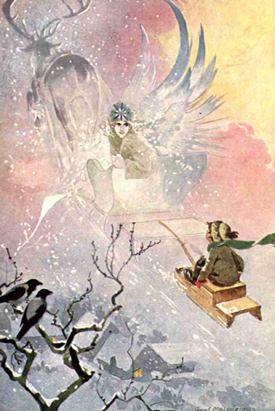|
The Snow Queen in Myth and LiteratureBy Tala Bar The Snow Queen is a well-known story by Hans Christian Andersen, but
as strange as it may seem, Andersen's is not the only Snow Queen, either
in literature or in mythology. Another strange phenomenon is that this
Snow Queen must, by her very nature, be an evil being, or at least cruel
and harsh. There have been some psychological interpretations to Andersen's
story, including his own, but here is a more basic, mythological explanation,
not only of this particular Snow Queen but of others of her ilk. Anderson's Snow Queen lives at the North Pole, and here is a description
of her habitation, taken from a translation appearing on a site
of Andersen's stories: "The walls of the palace were formed
of drifted snow, and the windows and doors of the cutting winds... There
were more than a hundred rooms in it, all as if they had been formed
with snow blown together; they were all lighted up by the vivid light
of the aurora, and they were so large and empty, so icy cold and glittering!...
In the midst of its empty, endless hall of snow was a frozen lake..."
This was the place where she put the boy she had kidnapped: "Little
Kay was quite blue with cold, indeed almost black, but he did not feel
it; for the Snow Queen had kissed away the icy shivering, and his heart
was already a lump of ice." The aurora marks that place as situated around the North Pole, and
the scene describes a land where Winter rules, in the midst of which
Little Kay is death frozen. Since the arrival of the Snow Queen, eternal
winter has ruled the land, and nothing is able to stay alive. This characterizes
her plainly as a Winter goddess, in whose land nothing grows, and every
living being dies of cold. Such winter is typical of Northern Europe,
the place where such legends come from. The character of the Snow Queen is not only cold in nature. She is
also portrayed as harsh and cruel, like the winter in northern countries.
This kind of cold is also associated with white, the color of the snow,
which in some cultures is regarded as the color of death. Andersen's
story tells of the struggle for Kay's heart between the Snow Queen and
the girl Gerda; in contrast to the Queen and her white Winter, Gerda
is highly emotional, and her nature is associated with red roses, who
plainly signify the revival of Spring. Thus, what we actually have here
(and in spite of Andersen's own interpretation), is a picture of the
seasonal struggle between Winter and Spring, in the tradition of pagan
mythology. As to Kay, he is an integral part of that mythology. Both his character
and his name are taken from the Celtic myth of King Arthur, in which
his name is spelled Kai; that is also the way Eileen
Kernaghan spells the boy's name in her book about the Snow Queen.
In the original myth, Kai was a Sun hero born to a virgin mother at
midwinter. It is very easy to see the Snow Queen as a virgin who has
no mate, and her relation to Kai looks more like an alienated mother
to her son than a loving woman to her mate. In Andersen's story she
tries to teach Kai a rational way of thinking, which is the opposite
of Gerda's approach. That girl, his good friend and would-be lover,
tries to teach Kai the ways of life and love, as befitting a Goddess
of Spring.
|
